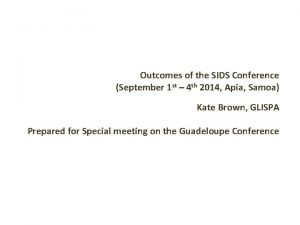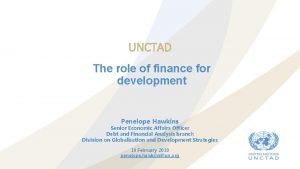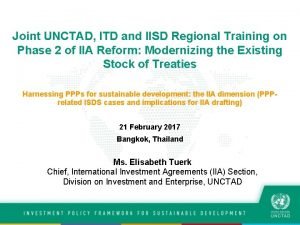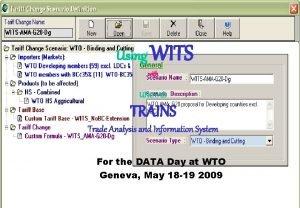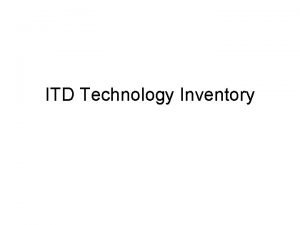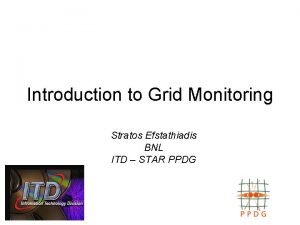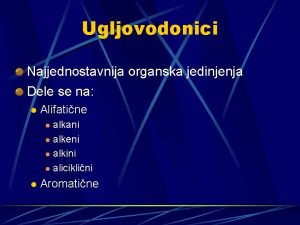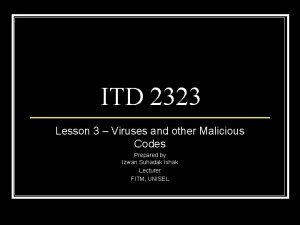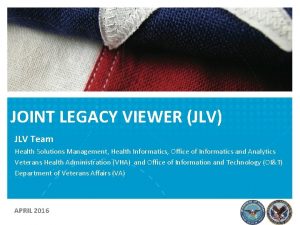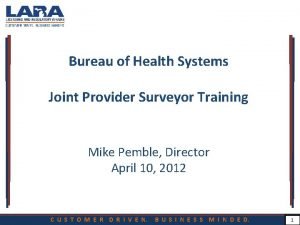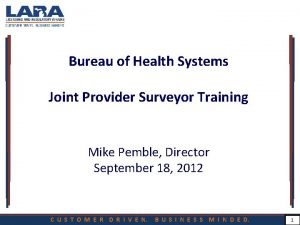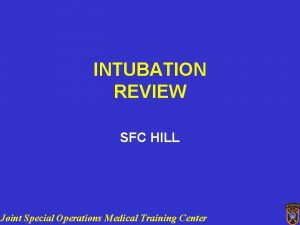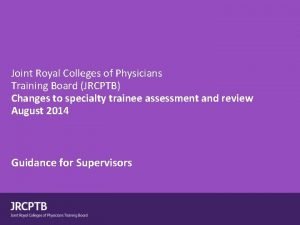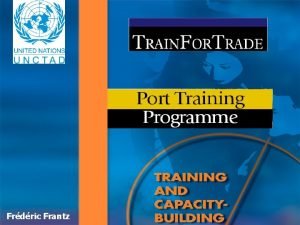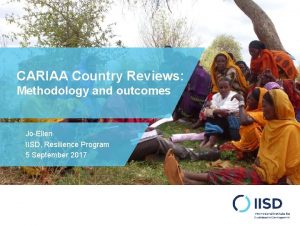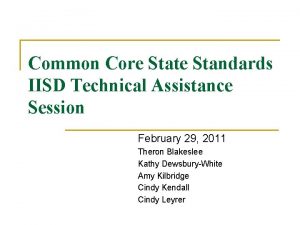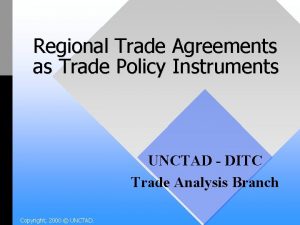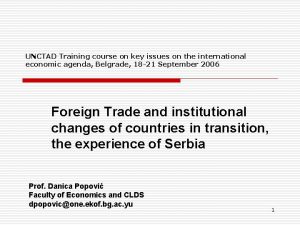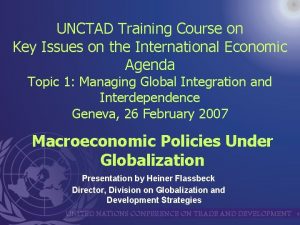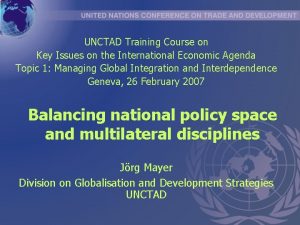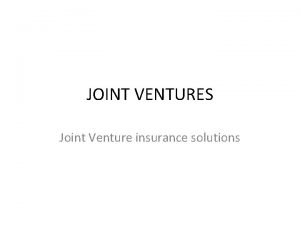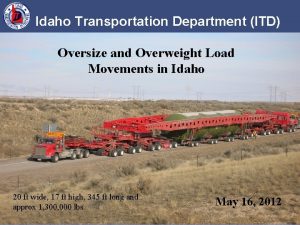Joint UNCTAD ITD and IISD Regional Training on




























- Slides: 28

Joint UNCTAD, ITD and IISD Regional Training on Phase 2 of IIA Reform: Modernizing the Existing Stock of Treaties Harnessing PPPs for sustainable development: the IIA dimension (PPPrelated ISDS cases and implications for IIA drafting) 21 February 2017 Bangkok, Thailand Ms. Elisabeth Tuerk Chief, International Investment Agreements (IIA) Section, Division on Investment and Enterprise, UNCTAD

Customizing UNCTAD IIA and ISDS Navigators

Trends in ISDS: The rate of new treaty-based ISDS cases continues unabated PPP-related ISDS cases per SDG sector Source: © UNCTAD, World Investment Report 2017.

Electricity is the most common economic sector involved in PPPrelated ISDS claims

Electricity is the most common economic sector involved in PPP-related ISDS claims PPP-related ISDS cases per SDG sector Source: © Forthcoming on UNCTAD’s PPP Policy Hub. Based on 767 known, treaty-based ISDS cases. Note: Cases may be mapped twice if they involve two sectors (e. g. many of the power generation/renewable energy protection projects include the construction of the power generation facility).

Outcomes of PPP-related ISDS cases by economic sector • Electricity: • 19 “won”, 15 lost by Respondent, 103 pending • Highest amount claimed: Libananco v Turkey (10 billion USD) • Highest amount awarded: Total v Argentina (270 million USD) • Construction: • 6 “won”, 4 lost by Respondent, 10 pending • Highest amount claimed: Trans. Canada v USA (15 billion USD) • Highest amount awarded: ADC v Hungary (76 million USD) • Transportation: • 6 “won”, 6 lost by Respondent, 9 pending • Highest amount claimed: Trans. Canada v USA (15 billion USD) • Highest amount awarded: ADC v Hungary (76 million USD)

Outcomes of PPP-related ISDS cases by economic sector • Water and sanitation: • 4 “won”, 9 lost by Respondent, 16 pending • Highest amount claimed: Vivendi v Argentina (834 million USD) • Highest amount awarded: Vivendi v Argentina (383 million USD) • Health: • 2 “won”, 0 lost by Respondent, 0 pending • Highest amount claimed: Dialasie v Viet Nam (47 million USD) • Highest amount awarded: Data not available

PPP-related claims in the agricultural sector • Def. “agri-PPP”: “A formalized partnership between public institutions and private partners designed to address sustainable agricultural development objectives, where the public benefits anticipated from the partnership are clearly defined, investment contributions and risks are shared, and active roles exist for all partners at various stages throughout the PPP project lifecycle. ” (FAO 2016) • E. g. partnerships to develop agricultural value chains, for joint agricultural research, for building or upgrading market infrastructure etc. • Of 30 known, treaty-based ISDS cases (1987 -2016), none was in relation to an “agri-PPP”

Relevance of IIA clauses for Public Private Partnerships (PPPs)

Key IIA Clauses • Definition of investment clauses • In accordance w domestic law clauses/anti-corruption clauses • Fair and equitable treatment clauses • Umbrella clauses • ISDS clauses • More recent clauses with PPP reference

Definition of investment • For a PPP to be covered by an IIA, it needs to fall under the definition of investment set out in the IIA. • The broader the notion of investment contained in a BIT, the more easily investments based on PPP contracts qualify as protected investment and the greater is the potential exposure of host State to ISDS claims in relation to PPPs.

While the enterprise-based definition is on the rise in recent IIAs, both the enterprise as well as the asset-based definition give IIA coverage to PPPs Share of BITs containing asset-based, enterprise-based and no investment definition, signed between 1959 -2016 Source: © Forthcoming on UNCTAD’s PPP Policy Hub. Based on 2’ 538 mapped BITs signed between 1959 and 2016. *Total number of mapped BITs that were signed period. Note that the presented three options are mutually exclusive, a BIT can have either an asset-based or an enterprise-based definition (or no definition at all), but not both.

Canada is the main user of the enterprise-based investment definition Top ten countries concluding BITs with enterprise-based definition (by number of BITs) Source: © Forthcoming on UNCTAD’s PPP Policy Hub. Based on 2’ 538 mapped BITs signed between 1959 and 2016.

“In accordance with host State laws” and “anticorruption” clauses • By attaching IIA-based legal relevance to investor behavior, legality requirements (encompassing, among others, “in accordance with domestic law” clauses and “anti-corruption” clauses) can help strengthen the investor responsibility dimension of PPPs and exclude coverage of investments having violated such provisions.

The majority of BITs contain “in acc. W. host State law” clauses, and “anti-corruption” clauses are on the rise in new-generation BITs Number and share of BITs containing an “in accordance with host State law”/”anti-corruption” clause, signed between 1959 and 2016 Source: © Forthcoming on UNCTAD’s PPP Policy Hub. Based on 2’ 538 mapped BITs signed between 1959 and 2016. * Total number of mapped BITs that were signed period. Note that the presented options “in accordance with host State law” and no “in accordance with host State law” clause are mutually exclusive, while the options “in accordance with host State law” clause and “anti-corruption” clause are not mutually exclusive. A BIT can therefore have or not have an “in accordance with host State law” clause as well as an “anti-corruption” clause.

Fair and equitable treatment (FET) clauses • FET clauses touch directly on interactional processes (e. g. tender phases) between the government and the private investor typical of PPPs. • FET is also the IIA clause on which ISDS claims are most frequently based.

Almost four-fifth of all BITs signed contain unqualified FET clauses Share of BITs with unqualified, qualified and no FET clause, signed between 1959 and 2016 Source: © Forthcoming on UNCTAD’s PPP Policy Hub. Based on 2’ 538 mapped BITs signed between 1959 and 2016. “Qualified” FET clauses refer to both clauses containing reference to the minimum standard of treatment/customary international law and containing lists of treatments that constitute breaches of FET.

BITs containing qualified FET clauses are on the rise Number and share of BITs with unqualified, qualified and no FET clause, signed between 1959 and 2016 Source: © Forthcoming on UNCTAD’s PPP Policy Hub. Based on 2’ 538 mapped BITs signed between 1959 and 2016. * Total number of mapped BITs that were signed period. “Qualified” FET clauses refer to both clauses containing reference to the minimum standard of treatment/customary international law and containing lists of treatments that constitute breaches of FET.

Umbrella clause • By elevating non-treaty commitments (such as contractual obligations assumed by the State) to the treaty level, umbrella clauses provide the foreign investor with the possibility to bring an ISDS case in the event of breach of this commitment.

While umbrella clauses were more prevalent in old-generation BITs, new-generation BITs frequently do without them Number and share of BITs with and without umbrella clause, signed between 1959 and 2016 Source: © Forthcoming on UNCTAD’s PPP Policy Hub. Based on 2’ 538 mapped BITs signed between 1959 and 2016. * Total number of mapped BITs that were concluded by period.

BITs with umbrella clauses hit an all-time high in the 1990 s and early 200 s, but are largely absent from new-generation BITs Evolution of BITs with umbrella clause, signed between 1959 and 2016 Source: © Forthcoming on UNCTAD’s PPP Policy Hub. Based on 2’ 538 mapped BITs signed between 1959 and 2016.

In particular capital-exporting countries have included umbrella clauses in their old-generation BITs Top ten countries concluding BITs with umbrella clause (by number of BITs) Source: © Forthcoming on UNCTAD’s PPP Policy Hub. Based on 2’ 538 mapped BITs signed between 1959 and 2016.

ISDS clauses • Dispute settlement clauses typically determine which kind of disputes the contracting States agree to submit to investor-State arbitration. • Depending on whether the “consent to dispute settlement” clause is narrowly or broadly framed, the host State may be exposed to ISDS claims based only on alleged breaches of a treaty or also based on other legal grounds (e. g. breach of contract).

Close to three-quarter of all BITs signed contain broad ISDS clauses Share of BITs containing broad, list-based, treaty-based only or no ISDS clause, signed between 1959 and 2016 Source: © Forthcoming on UNCTAD’s PPP Policy Hub. Based on 2’ 538 mapped BITs signed between 1959 and 2016. The category “Other” refers to BITs that were mapped as “other”, “inconclusive” or “not applicable”.

The share of BITs containing narrow ISDS clauses, covering only treaty-based claims, is on the rise in new-generation BITs Number and share of types of DS clauses in BIT, signed between 1959 and 2016 Source: © Forthcoming on UNCTAD’s PPP Policy Hub. Based on 2’ 538 mapped BITs signed between 1959 and 2016. * Total number of mapped BITs that were concluded by period. The category “Other” refers to DS clauses that were mapped as “other”, “inconclusive” or “not applicable”.

IIA clauses: Some new-generation IIAs now make explicit reference to PPPs for purposes of investment promotion/facilitation • Morocco-Nigeria BIT (2016), Article 5(3): • “The Parties shall also discuss initiatives to strengthen the role of investors in Public-Private Partnerships (PPPs), especially through greater transparency and early access to regulatory information”. • Brazil-Chile BIT (2015), Art. 20(2): • “Las Partes proporcionarán, cuando se les solicite, con celeridad, información, entre otros, sobre los siguientes puntos: … (m) información pública sobre Alianzas Público-Privadas “

Join us for further debate!

THANK YOU!
 Iisd
Iisd Karaindros development
Karaindros development Unctad
Unctad Unctad trains
Unctad trains Unctad objetivos
Unctad objetivos Bnl itd helpdesk
Bnl itd helpdesk Stratos efstathiadis
Stratos efstathiadis Heptan oktan nonan dekan
Heptan oktan nonan dekan Itd worms
Itd worms Joint regional intelligence center
Joint regional intelligence center Permanent joints
Permanent joints Saddle joint example
Saddle joint example Spool joint lamb
Spool joint lamb What type of joint is the intervertebral joint
What type of joint is the intervertebral joint Memorandum of joint venture
Memorandum of joint venture Break joint vs spool joint
Break joint vs spool joint Wmo regional training centres
Wmo regional training centres Tasfaa regional training
Tasfaa regional training Wmo regional training centres
Wmo regional training centres Western regional training center
Western regional training center Joint legacy viewer website
Joint legacy viewer website Joint services adventure training
Joint services adventure training Joint provider surveyor training michigan
Joint provider surveyor training michigan Joint provider surveyor training michigan
Joint provider surveyor training michigan Joint special operations medical training center
Joint special operations medical training center Msf jrcptb
Msf jrcptb Joint royal college of physicians training board
Joint royal college of physicians training board Training is expensive without training it is more expensive
Training is expensive without training it is more expensive Metode of the job training
Metode of the job training
